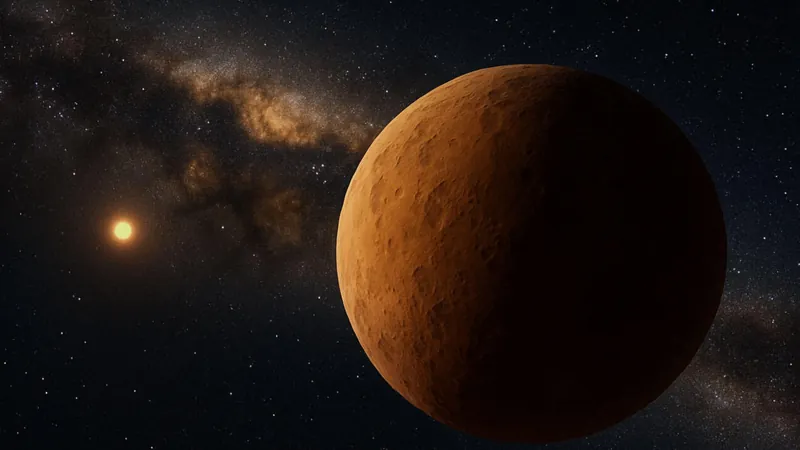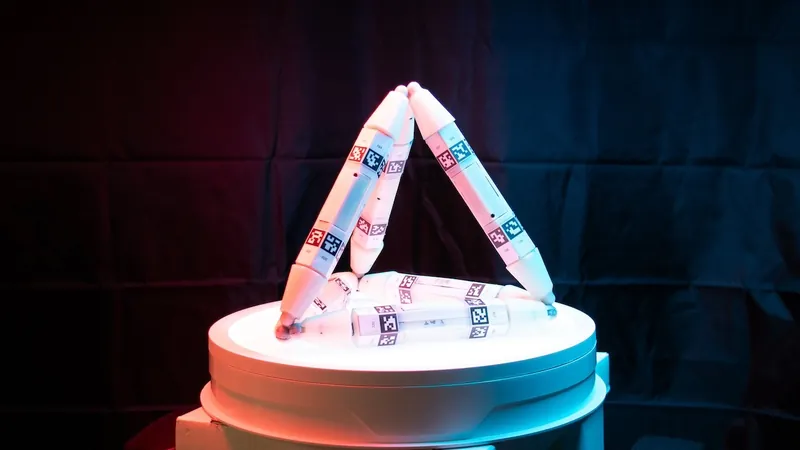
Astronomers Unearth Cosmic 'Fossil' at Solar System’s Edge – What It Means for 'Planet 9'!
2025-07-16
Author: Charlotte
A Groundbreaking Discovery Beyond Pluto!
In a stunning revelation, astronomers have uncovered a colossal celestial body lurking beyond Pluto’s orbit, stirring excitement and speculation in the scientific community. Dubbed 'Ammonite,' this newly identified object—officially labeled 2023 KQ14—boasts an unusual elongated orbit that raises critical questions about the elusive 'Planet Nine.' Is it much farther from the Sun than we ever imagined, or has it been flung from our solar system?
What Makes 'Ammonite' So Fascinating?
Categorized as a 'sednoid,' Ammonite is one of only four known bodies classified within this unique group of trans-Neptunian objects (TNOs). Sednoids are characterized by their highly eccentric orbits and extreme distances from the Sun, with 2023 KQ14 coming closest at a staggering 71 times the distance between Earth and our Sun. With a diameter ranging between 136 to 236 miles (220 to 380 kilometers), this cosmic giant is a whopping 45 times wider than Mount Everest!
A Dramatic History at the Solar System's Frontier!
Astoundingly, Ammonite's orbit has remained stable for 4.5 billion years, suggesting it has a rich past intertwined with the solar system's formation. Researchers from the Formation of the Outer Solar System: An Icy Legacy (FOSSIL) project, which utilized the Subaru Telescope for this groundbreaking find, believe that 2023 KQ14 and its fellow sednoids once shared similar orbits 4.2 billion years ago. This implies a cataclysmic event shaped the outer solar system shortly after its birth.
Is This the End of Planet Nine?!
The singular orbit of 2023 KQ14 raises critical doubts about the existence of Planet Nine, a hypothetical planet theorized to exist at the solar system's edge. According to Yukun Huang, the leading researcher from the National Astronomical Observatory of Japan, the disparities in these orbits make the Planet Nine hypothesis less probable. 'It’s conceivable that a planet once lingered here but was propelled into the void, altering the orbits of those it left behind,' Huang explained.
The Journey of Discovery!
Discovered through the Subaru Telescope's wide field of view between March and August 2023, 2023 KQ14 underwent confirmation during follow-up observations with the Canada-France-Hawaii Telescope in July 2024. By analyzing nearly two decades of archival data, astronomers meticulously reconstructed its trajectory, illuminating the cosmos' secrets.
Unraveling the Solar System's Mysteries!
In their quest to understand more about 2023 KQ14, Huang and the FOSSIL team utilized advanced numerical simulations, confirming its orbital stability over billions of years. 'The discovery of such elongated orbits far from Neptune suggests that significant events influenced these distant realms during the solar system's formative years,' stated planetary scientist Fumi Yoshida. As one of the few observatories capable of such groundbreaking discoveries, the Subaru Telescope stands at the forefront of unraveling the intricate history of our solar system.
A New Era for Cosmic Exploration!
With the potential of uncovering more celestial wonders like 2023 KQ14, astronomers are eager to piece together the mysteries of our cosmic neighborhood. 'Understanding these unique objects is essential for a comprehensive picture of our solar system's past,' Yoshida concluded, leaving us all on the edge of our seats for what’s next in this ongoing interstellar adventure!









 Brasil (PT)
Brasil (PT)
 Canada (EN)
Canada (EN)
 Chile (ES)
Chile (ES)
 Česko (CS)
Česko (CS)
 대한민국 (KO)
대한민국 (KO)
 España (ES)
España (ES)
 France (FR)
France (FR)
 Hong Kong (EN)
Hong Kong (EN)
 Italia (IT)
Italia (IT)
 日本 (JA)
日本 (JA)
 Magyarország (HU)
Magyarország (HU)
 Norge (NO)
Norge (NO)
 Polska (PL)
Polska (PL)
 Schweiz (DE)
Schweiz (DE)
 Singapore (EN)
Singapore (EN)
 Sverige (SV)
Sverige (SV)
 Suomi (FI)
Suomi (FI)
 Türkiye (TR)
Türkiye (TR)
 الإمارات العربية المتحدة (AR)
الإمارات العربية المتحدة (AR)